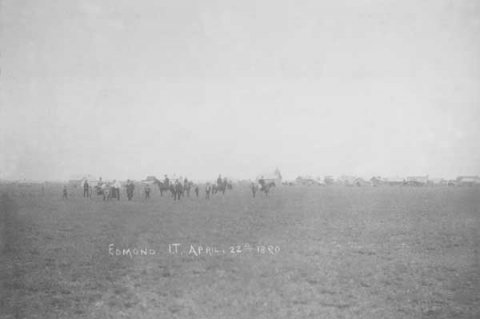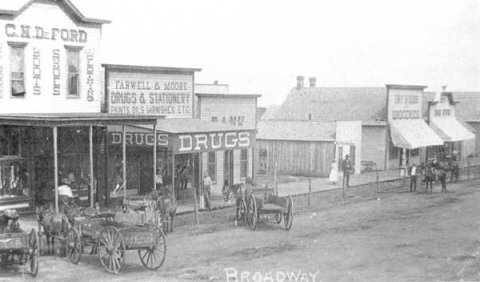Description:
It may have been the most publicized incident of the 1889 Oklahoma Land Run: the image of a brave and determined young woman perched on the cowcatcher of a north bound train. Nanitta R.H. “Kentucky” Daisey, a reporter for the Dallas Morning News, jumped from the train and planted her stakes in order to claim a piece of land near Edmond Station, dashing back in time to be pulled onto the train’s caboose.
Once a peaceful prairie, home to herds of bison, black bears, and the occasional band of Indian hunting parties, the site now called Edmond was the highest point along the Santa Fe rail line in Oklahoma Territory. In 1884, when Congress approved the Southern Kansas Railroad Company’s request to build a line south through Indian Territory, wilderness soon gave way to settlement. Mile Marker 103 was established as a site to provide fuel and water for trains passing along the railroad. A pump house, manned by John N. Steen and his family, became the residence of the first permanent family in what would become the City of Edmond, the name chosen and filed by Santa Fe Railroad officials.
“Kentucky” Daisey was only one of a multitude of eager homesteaders with hopes of claiming property around the Santa Fe station. Much like the founding of Oklahoma City, the original plat for Edmond was prepared by the Seminole Townsite Company, which had ties to the railroad. And, as in Oklahoma City, rivalries developed almost immediately over townsite plans by competing factions.
In May of 1889 an election was held for a temporary mayor and council, and on June 1, 1889, a second resulted in electing J.J. Hunt as official mayor, along with other city officers. Edmond’s population was 394 in the 1890 census.
Edmond was viewed as a potential boomtown due to its location midway between Oklahoma City and Guthrie, access to the railroad, and its rich farming land. Another boon to development was the establishment of the Territorial Normal School, which provided two years of higher education for teachers. Edmond also experienced several oil booms: the discovery of the Messer No. 1 in 1930, a 1934 blow-out at the Amerada-Stanolind No. 1 Suenram, and the No. 1 Lynn Wagner, brought in during 1943.
According to the 2000 U.S. Census, the city’s population was estimated at 68,315 people. It continues to be one of the most rapidly growing suburban cities in Oklahoma County. The University of Central Oklahoma, which grew and evolved from the Territorial Normal School, is an integral part of the community.
Edmond is the home of Shannon Miller, winner of seven Olympic medals in women’s gymnastics and professional wrestler Charlie Haas was a 1991 graduate of Edmond Memorial High School.
Resources:
"Birth of Harrah.” History of Harrah. 2007. http://www.harrah-ok.gov/
Blackburn, Bob L. Heart of the Promised Land: Oklahoma County: an Illustrated History. Woodland Hills, CA: Windsor Publications, 1982.
Crowder, James L. Historic Edmond: an illustrated history. San Antonio, Tex.: Historical Publishing Network, 2000.
Faulk, Odie B., Laura E. Faulk and Bob L. Blackburn. Oklahoma City: A Centennial Portrait. Northridge, CA: Windsor Publications, 1988.
Fugate, Francis L., and Roberta B. Fugate. Roadside history of Oklahoma. Missoula, MT: Mountain Press Pub., 1991.
Hoig, Stan. The early years of Edmond. Edmond, Okla.: S. Hoig, 1976.
Hoig, Stan. Edmond-- the first century. Edmond, Okla.: Edmond Historic Preservation Trust, 1987.
Mattingly, Jan. Edmond, Oklahoma: always growing. Chicago, IL, Arcadia Pub., 2002.

